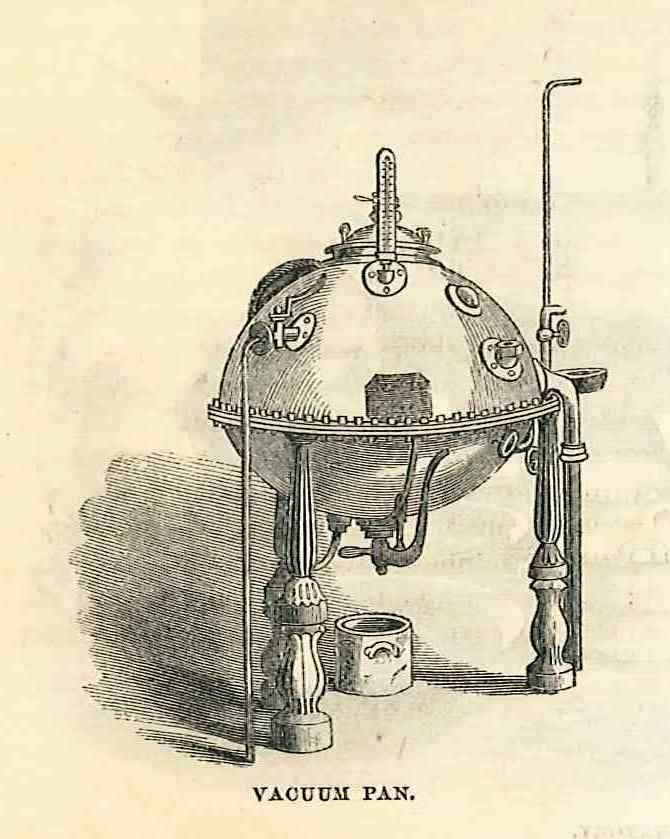
Benson John Lossing, “The Shakers,” Harper’s New Monthly Magazine 13 (July, 1857), p. 174, Shaker Museum | Mount Lebanon: 1853.6623.1.
In the September 1999 issue of Smithsonian Magazine, Carolyn Hughes Crowley presented an article in the “The Object at Hand” column titled, “The Man Who Invented Elsie, the Borden Cow.” The article was sparked by an “oddly shaped copper kettle officially designated as a ‘vacuum pan’” that, at the time, sat in a corner of the Smithsonian National […]

Postcard. Elder Alonzo Giles Hollister Standing Next to the Shakers’ Vacuum Pan, Laboratory, Center Family, Mount Lebanon, NY, Ca. 1910, Shaker Museum | Mount Lebanon: 2008.21701.1.
In the September 1999 issue of Smithsonian Magazine, Carolyn Hughes Crowley presented an article in the “The Object at Hand” column titled, “The Man Who Invented Elsie, the Borden Cow.” The article was sparked by an “oddly shaped copper kettle officially designated as a ‘vacuum pan’” that, at the time, sat in a corner of the Smithsonian National Museum of American History. The vacuum pan was acquired from the Borden Company. The Borden Company, however, acquired the pan from the Shaker community at Mount Lebanon in 1931 through Sister Emma J. Neale, because it had an association with the company’s founder Gail Borden.
The story of Gail Borden, briefly told, is one of a man obsessed with developing products that would improve people’s lives. Born in Norwich, New York in 1801, Borden settled in Texas in 1829 where he worked as a land surveyor, newspaper publisher, and passionate inventor. When his 32 year old wife and four year old son died of yellow fever, Borden, observing that the fever subsided during the winter, suggested building refrigerators to keep people in an environment that was too cold for the fever to take hold. In the 1840s he dehydrated beef, mixed it with flour, and formed it into biscuits that provided considerable sustenance packed into an easily portable form that did not spoil on long voyages. He hoped to market them to the Army but soldiers found them less palatable than similar product made by competitors. In 1851, aboard a ship from England, where he had exhibited his meat biscuits at the London Crystal Palace Exposition, Borden witnessed children dying from a lack of milk from shipboard cows. His work with meat biscuits convinced him that any food, milk included, could be condensed and preserved. Others had tried to condense milk by boiling it but it inevitably burned and turned sour over an open fire. Borden, after returning to New York, learned of the Mount Lebanon Shakers’ use of a vacuum pan to condense medicinal fluids. The vacuum allowed the Shakers to boil off liquid at low temperatures, thereby concentrating the fluids without affecting their medicinal potency. In 1853 Borden went to stay with the Shakers at the Center Family and made an arrangement to use their vacuum pan to experiment with condensing milk. His experiments succeeded and in 1856 Borden was granted a patent for his process. Shortly after his patent was granted he opened his first successful milk condensing factory in Wassaic, New York and the Borden Company, including Elsie the Cow, became part of the annals of the consumer world.

John Benson to Brother Edward Fowler, Church Family, Mount Lebanon, NY, Assignment of Perpetual Right to Use the Vacuum Pan Known As “Benson & Day’s Patented Improved Vacuum Pan,” July 25, 1850, Shaker Museum | Mount Lebanon: 1957.9564.1.
How the Shakers came upon the idea of using a vacuum pan for reducing medicines is not known, but it is known that in 1850 they obtained the right to the perpetual use of “Benson & Day’s Patented Improved Vacuum Pan.” These rights were assigned to Brother Edward Fowler, trustee of the Church and Center Families at Mount Lebanon. John Benson and James Day of Brooklyn, New York, patented their vacuum pan in 1848 as an improvement for boiling away the liquid from cane molasses to make sugar.
The story as told makes a clear case for the Borden Company’s interest in the Shakers’ vacuum pan and its subsequent acquisition by the Smithsonian. There is, however, a small twist in this story that has not been told. Buried in a diary kept in the Mount Lebanon Church Family by Deaconess Anna Dodgson is the following information from February 19, 1880: “The Vacuum Pan failed some weeks since at Laboratory, having stood the test of 30 years usage, A New One arrives to day.” The Shaker vacuum pan acquired by the Borden Company and preserved at the Smithsonian is not the same one that Gail Borden used!

Benson John Lossing, “The Shakers,” Harper’s New Monthly Magazine 13 (July, 1857), p. 174, Shaker Museum | Mount Lebanon: 1853.6623.1.

Shaker Almanac 1885: Joys and Sorrows of a Poor Old Man, [New York, NY: A. J. White, 1884], p. 7, Shaker Museum | Mount Lebanon: 1950.4360.1.